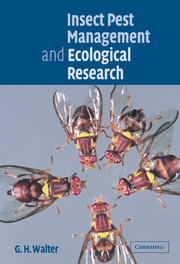Book contents
- Frontmatter
- Contents
- Preface
- Acknowledgements
- 1 Introduction
- Part 1 The place and nature of insect ecology research for IPM
- Part 2 Specific directions in insect ecology research for IPM
- 6 Understanding species: good taxonomy, sexual species and pest management
- 7 Polyphagous pests, parasitoids and predators: trophic relations, ecology and management implications
- 8 Pre-release evaluation and selection of natural enemies: population and community criteria
- 9 Autecological research on pests and natural enemies
- Part 3 Synopsis: Ecological research for IPM today
- References
- Index
7 - Polyphagous pests, parasitoids and predators: trophic relations, ecology and management implications
Published online by Cambridge University Press: 22 August 2009
- Frontmatter
- Contents
- Preface
- Acknowledgements
- 1 Introduction
- Part 1 The place and nature of insect ecology research for IPM
- Part 2 Specific directions in insect ecology research for IPM
- 6 Understanding species: good taxonomy, sexual species and pest management
- 7 Polyphagous pests, parasitoids and predators: trophic relations, ecology and management implications
- 8 Pre-release evaluation and selection of natural enemies: population and community criteria
- 9 Autecological research on pests and natural enemies
- Part 3 Synopsis: Ecological research for IPM today
- References
- Index
Summary
[We] demonstrate the existence of significant amounts of variation in feeding and oviposition behaviour below the species level for both host preference, or degree of specialization to particular host plants, and host suitability. The study of such variation contributes greatly to the understanding of resource use and other ecological processes, and of adaptation to stressed environments such as are caused by agricultural practices.
l. m. schoonhoven et al. (1998, p. 219)Introduction
The range of principles and interpretations covered in the earlier chapters are applied in Chapters 7–9 to the investigation and interpretation of the ecology of pest and beneficial species, with emphasis on those aspects relevant to pest management. Chapters 7–9 are illustrative rather than exhaustive in that they cover only a minute subset of all ecological understanding and application relevant to IPM.
Chapter 7 deals with polyphagous species, which are those associated with many host types. Such species are considered to be generalists (e.g. Bernays & Chapman, 1994; Briese et al., 1994; Futuyma, 1991; Leather, 1991; Schoonhoven et al., 1998; Ward & Spalding, 1993) and are seen to provide a strong ecological contrast with host-specific herbivores and parasitoids, which are referred to as monophagous. Polyphagous species present special problems for ecological understanding and therefore for pest management, although many host-specific species are notorious pests (e.g. rice planthopper and olive fly). Herbivorous pests, parasitoids and predators are used to illustrate these difficulties and to help to plot a way around them.
- Type
- Chapter
- Information
- Insect Pest Management and Ecological Research , pp. 169 - 206Publisher: Cambridge University PressPrint publication year: 2003



